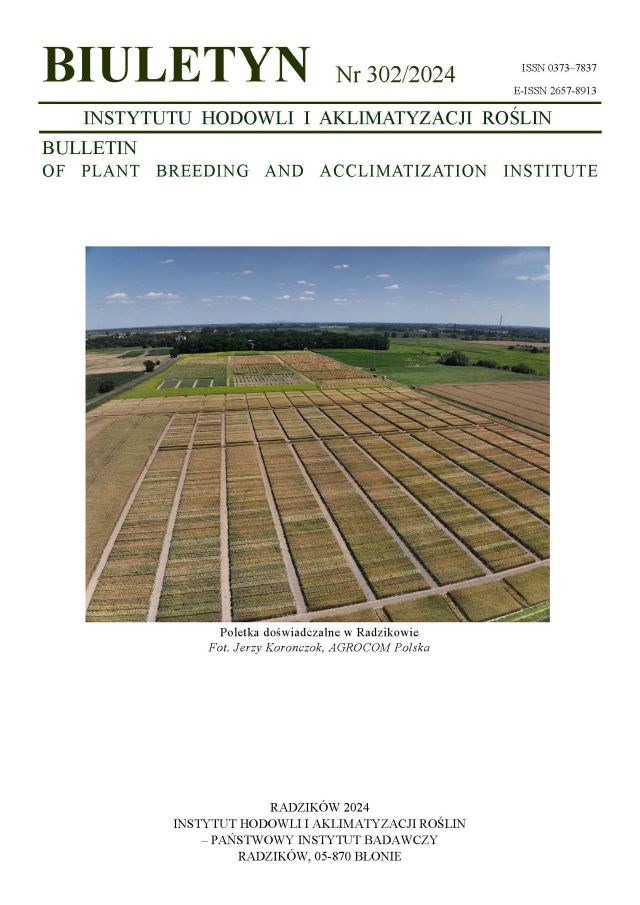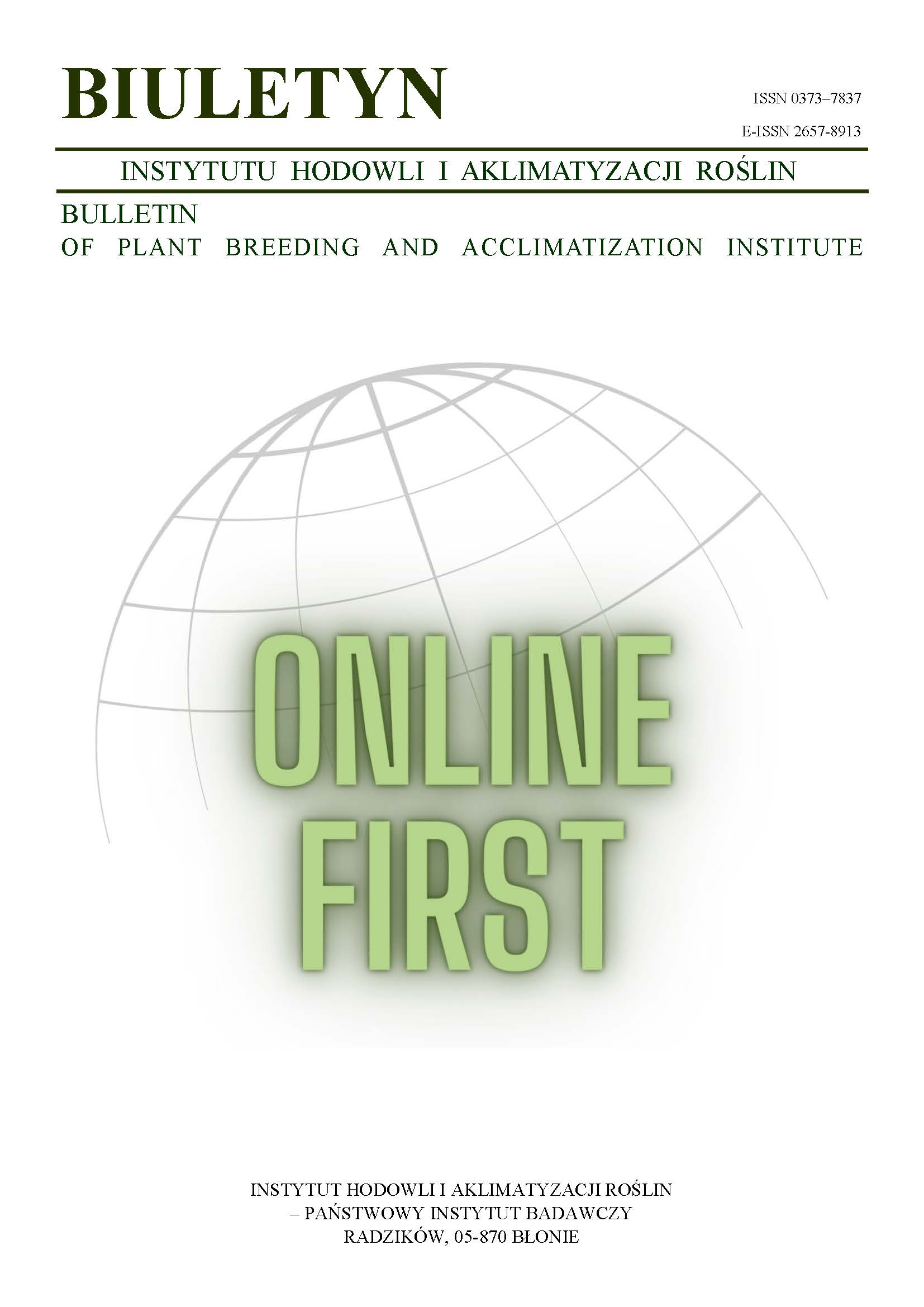Selection of self-compatible genotypes in multigerm diploid populations of sugar beet
Barbara Skibowska
b.skibowska@ihar.edu.plZakład Genetyki i Hodowli Roślin Korzeniowych, Instytut Hodowli i Aklimatyzacji Roślin, Oddział w Bydgoszczy (Poland)
Abstract
Monogerm diploid sugar beet varieties are hybrids between CMS lines and multigerm diploid pollinators. In creating sugar beet hybrids inbreeding is necessary to obtain suitable parental lines. These lines should possess valuable agronomic traits associated with a high combining ability. The investigations described in this paper are of great importance because of the recent tendency to produce diploid varieties that are comparable to triploid ones. The aim of the work was to select highly selfcompatible plants originated from a population as well as from pair crosses of diploid plants. In progenies coming from the population seed setting after self-pollination ranged from 2% to 25% in S1 generation, while in S2 generation it was 26.7%. In progenies originated from pair-crossed plants of the same origin seed setting of S1 generation varied in the range 2.6% to 66.7%, and from 4 to 36% in S2. In S1 a high proportion of seeds (15.9%) with only well developed pericarp was noted. Moreover, progenies of S2 generation showing a green-coloured hypocotyl were selected. These can be used for evaluating a crossing level and identifying selected lines.
Keywords:
diploids, self-compatible lines, sugar beetReferences
Bober K. 1997. Oszacowanie zdolności kombinacyjnej zapylaczy do produkcji genetycznie jednonasiennych odmian buraka cukrowego. Biul. IHAR 203: 159 — 183.
Google Scholar
Bosemark O. 1966. On the origin and consequences of aneuploidy in triploid and tetraploid sugar beet. J. Intern. Inst. Sugar Beet Res. 2: 9 — 34.
Google Scholar
Bosemark O. 1993. Genetics and breeding. In: The Sugar Beet Crop. Ed. Cooke and Scott.: 74 — 86.
DOI: https://doi.org/10.1007/978-94-009-0373-9_3
Google Scholar
Burba M., Jansen R. 2000. Geschichte. Gegenwärtiger Stand und künftige Perspektiven der Qualitätszüchtung bei Zuckerrüben. Zuckerind.: 591 — 602 (Teil I) und 803 — 814 (Teil II).
Google Scholar
COBORU. 2004. Lista odmian roślin rolniczych i warzywnych.: 9 — 10.
Google Scholar
Gośka M. 1997. Haploidy i podwojone haploidy buraka cukrowego (Beta vulgaris L.) oraz możliwości ich wykorzystania w hodowli. Rozprawy i Monografie Naukowe IHAR 2: 1 — 81.
Google Scholar
Gośka M., Kresińska T., Strycharczuk K. 2003. Wykorzystanie gynogenezy in vitro dla uzyskania dihaploidów buraka cukrowego. II Krajowy Kongres Biotechnologii. Łódź: 135.
Google Scholar
Jassem M., Sadowski. 1995. Factors influencing the quality of sugar beet seed produced in Poland. 58th Congress of II RB: 64 — 70.
Google Scholar
Słoma B. 2002. Wartość nasienna odmian buraków cukrowych reprodukowanych w zróżnicowanych warunkach agroekologicznych. Biul. IHAR 222: 165 — 170.
Google Scholar
Szota M. 1977. Zaburzenia w mikrosporogenezie a płodność roślin poliploidalnych. Część I. Przebieg mikrosporogenezy u buraków 2x, 3x 4x, kapusty pastewnej 4x i mieszańca kapusty pastewnej 4x z kapustą głowiastą i jej wpływ na płodność. Hod. Rośl. Aklim. 21: 33 — 46.
Google Scholar
Szota M., Skibowska B. 2002. Wykorzystanie mikroskopii fluorescencyjnej do identyfikacji samopłodności buraka cukrowego. Zesz. Probl. Post. Nauk Roln. 488: 233 — 237.
Google Scholar
Szota Z. 1968. Badania nad heterozją u buraków cukrowych w oparciu o linie homozygotyczne pod względem barwy hipokotylu. Hod. Rośl. Aklim. 12: 481 — 521.
Google Scholar
Svirshchevskaya A. 2001. New germplasm through gynogenesis in sugar beet. In: Broad variation and precise characterization-limitation for the future. Eucarpia: 100 — 105.
Google Scholar
Svirshchevskaya A., Dolezel J. 2000. Production and perfomance of gynogenetic lines cultured in vitro. J. Am. Soc. Sugar Beet Techn. 37, 4: 117 — 133.
DOI: https://doi.org/10.5274/jsbr.37.4.117
Google Scholar
Authors
Barbara Skibowskab.skibowska@ihar.edu.pl
Zakład Genetyki i Hodowli Roślin Korzeniowych, Instytut Hodowli i Aklimatyzacji Roślin, Oddział w Bydgoszczy Poland
Statistics
Abstract views: 67PDF downloads: 22
License
Copyright (c) 2004 Barbara Skibowska

This work is licensed under a Creative Commons Attribution-ShareAlike 4.0 International License.
Upon submitting the article, the Authors grant the Publisher a non-exclusive and free license to use the article for an indefinite period of time throughout the world in the following fields of use:
- Production and reproduction of copies of the article using a specific technique, including printing and digital technology.
- Placing on the market, lending or renting the original or copies of the article.
- Public performance, exhibition, display, reproduction, broadcasting and re-broadcasting, as well as making the article publicly available in such a way that everyone can access it at a place and time of their choice.
- Including the article in a collective work.
- Uploading an article in electronic form to electronic platforms or otherwise introducing an article in electronic form to the Internet or other network.
- Dissemination of the article in electronic form on the Internet or other network, in collective work as well as independently.
- Making the article available in an electronic version in such a way that everyone can access it at a place and time of their choice, in particular via the Internet.
Authors by sending a request for publication:
- They consent to the publication of the article in the journal,
- They agree to give the publication a DOI (Digital Object Identifier),
- They undertake to comply with the publishing house's code of ethics in accordance with the guidelines of the Committee on Publication Ethics (COPE), (http://ihar.edu.pl/biblioteka_i_wydawnictwa.php),
- They consent to the articles being made available in electronic form under the CC BY-SA 4.0 license, in open access,
- They agree to send article metadata to commercial and non-commercial journal indexing databases.
Most read articles by the same author(s)
- Sandra Cichorz, Małgorzata Malicka, Kamilla Kużdowicz, Barbara Skibowska, Maria Gośka, Use of traditional and modern methods in the improvement of breeding material of sugar beet (Beta vulgaris L.) , Bulletin of Plant Breeding and Acclimatization Institute: No. 287 (2019): Special issue
- Kamilla Kużdowicz, Adam Sitarski, Barbara Skibowska, Search for diseases resistance and abiotic factors in sugar beet genetic resources , Bulletin of Plant Breeding and Acclimatization Institute: No. 283 (2018): Special issue














